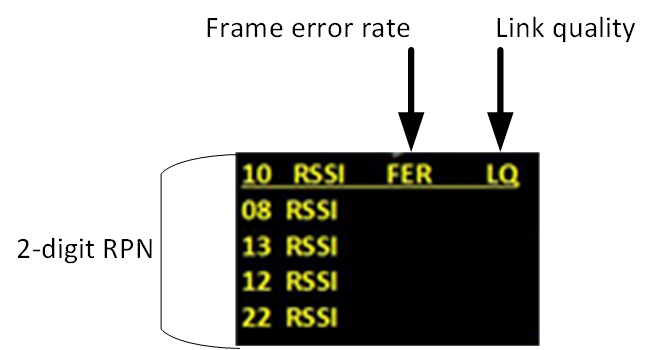Doing a site survey with a beltpack
- Link one beltpack to the matrix.
- Place one connected transceiver in the center of the coverage area.
- Put the beltpack into Site Survey mode using the beltpack menu. See Operating the wireless beltpack. The following figures show the information that the Site Survey mode displays for connected and unconnected beltpacks.


| Parameter | Meaning |
|---|---|
| Received Signal Strength Indication (RSSI) | A measure of the signal strength in a wireless environment. The higher the value, the stronger the signal. |
| Frame Error Rate (FER) | A measure of the signal connection quality. The lower the FER, the better the signal connection. |
| Link Quality (LQ) | A combined quality metric ranging from 1 (poor) to 5 (high). |
-
Walk around the transceiver with the beltpack, monitoring the beltpack signal strength and quality metrics.
- The signal strength is shown in the Received Signal Strength Indication (RSSI) field.
- The signal strength number will fluctuate, ranging between 0 - 59 as you walk through the coverage area, and may even fluctuate as you stand still. As a rule-of-thumb the best system performance will be obtained when the signal strength remains at 30 or above. If the signal strength falls below 30 the beltpack may start losing audio. This is the limit of the coverage zone.
- A high Received Signal strength indication and a high Error rate may indicate that there is another RF system causing interference.
- A beltpack can transmit to a transceiver at a range of approximately 500m in good conditions.
- Draw a map of the coverage zone for the transceiver. The coverage zone is the area where the signal strength, as a rule-of-thumb, is 30 or above and the Line Quality is 3-5.
- Repeat this process for as many transceivers as necessary to cover the required area. Overlap coverage zones so that there is no area where the signal strength is below 30, and no area where the error rate is above a few percent.
- Adjust the transceiver placement to get the best coverage.

In some environments you might observe that despite having a high signal strength, the beltpack consistently reports a high error rate.
This could be due to two things:
- In-band interference from an RF source broadcasting in the DECT area of the spectrum. This can be verified using a DECT band monitor or by using a Spectrum Analyzer.
- Long Delay Spread Multipath, where the signal is bounced off a number of reflective surfaces, such as metal ceilings, gantries, walkways or other large structures. This problem is greatest where the reflective surface is large and exists at a range of distances from the transceiver. To reduce the problem, consider siting the transceiver where it cannot “see” the reflective surface or installing a reflector close to the transceiver between it and the reflective surface.